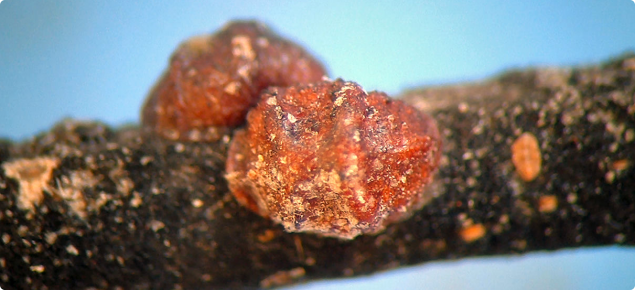Damage
- Black scales excrete a sugary substance known as honeydew, produced as a by-product of their feeding.
- Sooty mould fungi grow on top of the honeydew, coating leaves, twigs and fruit in a black powder.
- Sooty mould can interfere with plant photosynthesis, reducing tree vigour and yield, tainting the oil, increasing fruit washing costs at harvest, and higher spray costs.
- Severe infestations can cause early leaf-fall, die-back of the branches and even a lack of fruit for a few years.
Identification and developmental stages
There are two to three generations per year, depending on temperature and humidity.
In subtropical conditions where winters are milder, more generations are completed per year. Look for black scale on the leaves, twigs, branches and fruits. Identification of the correct developmental stage of black scale is crucial for chemical control. The immature stages — crawler and first instar — are most susceptible to insecticides.
- Eggs are laid under the body of the female and are 0.2‑0.3mm long. Initially pale orange in colour, they turn pink before hatching. Eyespots are visible within the eggs before they hatch as crawlers.
- Crawlers are the main dispersive stage, responsible for spread within and between olive groves. They can be dispersed passively such as by wind or on farm machinery, and actively, when the crawler wanders onto leaves and twigs. Although crawlers can wander for up to 36 hours, they usually settle within two to three hours. Most crawlers settle onto the mid-rib of the leaf, usually near the mother scale. Crawlers are light pink‑orange with black eyes and 0.2–0.3mm long.
- Once settled, crawlers shed their skin (moult) and become first instars. They are 0.6-0.75mm long and 0.2-0.35mm wide.
- Second instar. During this stage a longitudinal ridge begins to form along the middle of the scale. The body is pale brown with four dark brown patches,
0.6–0.8mm long and 0.3–0.4mm wide. - Third instar. Ridges are clearly present, with a light brown body that darkens with age, the dark patches are much bigger than the previous instar. They are
1–1.6mm long and 0.5–0.8mm wide. - The adult female is nearly circular, often with a ridged letter 'H' on its back. As the female approaches the egg-laying stage, the scales become dark, and mottled gray which is referred to as the 'rubber stage'. When egg laying commences the scale surface becomes smoother, darkening to black. Eggs are laid under the body of the female and she dies after laying eggs, although the body remains on the leaves or twigs.
Other scales
Other scales found on olives include parlatoria (Parlatoria oleae [Colvée]), red scale (Aonidiella aurantii), latania (Hemiberlesia lataniae), Ross’s black scale (Lindingaspis rossi) and circular black scale (Chrysomphalus aonidum). These are regarded as minor olive pests.
Chemical control
- In conventional olive groves, growers use a combination of narrow range mineral or petroleum oils and/or an insecticide such as an insect growth regulator to control black scale, while organic growers are restricted to oils.
- Correct timing of sprays is essential for successful control, since insecticides are only effective against young scales (crawlers, first and second instars).
-
Check the APVMA and Infopest websites for the latest in chemical control.
Biological control
- Black scale has been the subject of biological control projects in the Australian citrus industry since 1902. From 1902 to 1947, 24 species of beneficial insects (22 parasites, two predators) were released for its control.
- These included Metaphycus anneckei in 1902 from South Africa and M. helvolus 1943–47 from the USA. From 1998 to 2003, M. helvolus and M. lounsburyi were released in citrus as part of a Horticulture Australia Ltd-funded project.
- Surveys as part of a Rural Industries Research and Development Corporation project in WA showed that the egg predator, Scutellista caerulea, is most common. M. helvolus and M. anneckei are poorly established.
- The effectiveness of S. caerulea is limited, because populations build up too late to prevent scale outbreaks.
- Establishment of M. helvolus and M. lounsburyi in olives is recommended. However, there may be problems in obtaining insects commercially for release.
- General predators such as lacewings and ladybirds also feed on black scale.
Ants
- Ant control is required where growers are interested in biological control, as ants harvest honeydew from black scale and protect the scale from parasites and predators. No insecticides are presently registered in olives for this purpose.
- Overseas, bait stations with liquid sugar and boric acid (organically acceptable) are available for ant control.


